Navigating the impressive network of trains in Germany can seem daunting at first. In this article, we’ll break down the differences between the ICE, Regional, S-Bahn, and U-Bahn services, making it straightforward for you to understand which train will suit your travel needs in Germany.
Germany’s train system is lauded for its efficiency and covers a wide spectrum of rail services designed for various distances, speeds, and purposes. However, this spectrum of services leads to a spectrum of choices which can be confusing when you are first traveling to Germany and trying to work out what types of train (and tickets) you should be taking.
At the pinnacle of speed and comfort, the Intercity-Express (ICE) trains whisk passengers across the country at high speeds, perfect for getting from one major city to another in a fraction of the time it would take by road. For shorter, regional routes, the Regionalbahn (RB) and Regionalexpress (RE) trains connect smaller towns and rural areas with larger cities, offering a slower but picturesque journey.

Commuters in metropolitan areas rely on the S-Bahn, a network of suburban trains that operate frequently and punctually, forming the arteries that keep the daily lifeblood of the cities pulsing.
Meanwhile, the U-Bahn, Germany’s subway system, moves thousands of city-dwellers and visitors alike beneath the bustling city streets.
Join me as we delve into the nuances of each train type and learn to navigate the tracks like a local. Whether you’re planning a swift cross-country adventure or a leisurely exploration of Germany’s charming towns, getting to grips with the rail system will enhance your journey.
Considering the 49 Euro Deutschland ticket for all public transport? Click here to read more.
Traveling to Germany? Click here to download your free Germany Trip Planning checklist. We’ll help you get ready for your trip!
Intercity-Express (ICE) Trains In Germany: High-Speed Marvel

Imagine you’re gliding across Germany at speeds that can reach up to 300 km/h. That’s what you experience on an Intercity-Express (ICE) train, the zenith of German high-speed rail services. ICE trains offer you not just a journey, but a sleek, punctual, and comfortable voyage from one major city to another.
As you settle into your seat, you’ll notice the spacious legroom, power sockets, and free Wi-Fi—amenities designed to enhance your travel experience. Quiet zones and onboard dining provide an added layer of comfort, whether you’re traveling for business or pleasure.

But the ICE isn’t the only high-speed train at your disposal. There’s the InterCity (IC) for long-distance routes at slightly lower speeds, and the EuroCity (EC) that takes you beyond Germany’s borders with similar comforts. Each train type is tailored to different needs, yet they all share the German commitment to efficiency and traveler satisfaction.
Onboard the ICE, you have a choice between two classes of service—second class and first class. In second class, expect comfortable seating with ample space to work or relax. There are four seats per row.
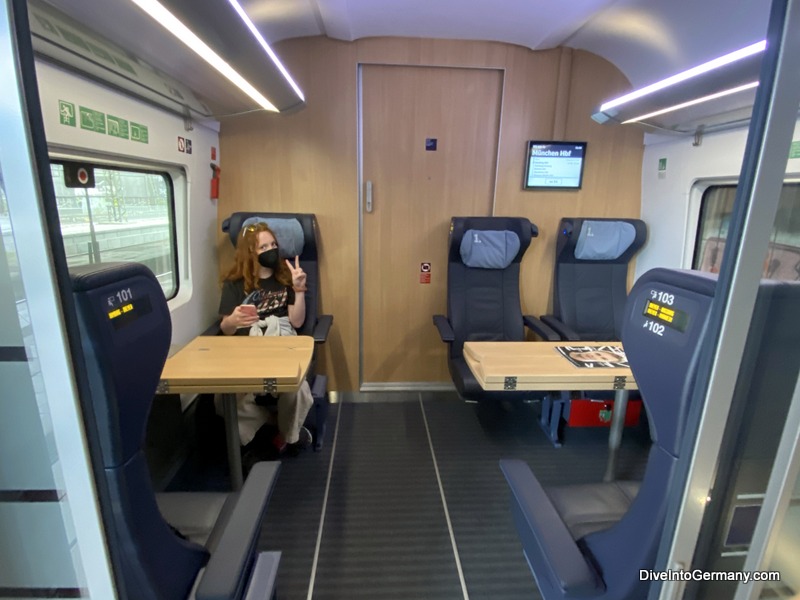
Opt for first class, and you’ll enjoy even more room (with three seats per row), quieter cabins, and complimentary newspapers. You also can order food and drinks to be served at your seat. It’s often only a little bit extra to purchase first class.
Regardless of the class, all passengers benefit from the same high standards of speed and convenience.
Note that seating isn’t guaranteed on these trains unless you purchase a seat assignment for an extra charge. I prefer to do this and pick a seat near a luggage rack (you’ll see them on the seating plan when you are booking).

Prices for tickets on these trains varies. Generally, booking ahead for a specific train will get you the best price. You are likely to pay far more if you wait until you are in Germany to buy tickets.
It’s very easy to buy your tickets here on the Deutsche Bahn website.
Pros of Traveling on High-Speed Trains:
- Speed: High-speed trains like the ICE cut down travel time significantly, making it possible to cross the country in hours rather than days. They are usually the fastest way to explore Germany.
- Frequency: Trains often run every hour, which means more flexibility and less waiting time for your journey.
- Comfort: Enjoy a higher level of comfort with spacious seating, onboard services, and amenities such as food service, Wi-Fi, and power outlets.
- Convenience: High-speed trains often connect major hubs directly, with no need for transfers, making trips smoother.
- Scenic Routes: Despite the speed, you still get to see the countryside and cities’ panoramas flash by your window in comfort.
Cons of Traveling on High-Speed Trains:
- Cost: High-speed train tickets can be more expensive than regional trains, especially if not booked in advance.
- Less Coverage: While they connect major cities, high-speed trains may not serve smaller towns, requiring a switch to local trains.
- Environmental Impact: Though trains are generally eco-friendly, high-speed trains consume more energy than slower regional trains.
ICE is generally your best option for trips between major cities and across the country. Note that you can’t take this high speed trains as part of the 49 Euro Deutschland Ticket.
Regional Trains In Germany: Exploring the Local Charm On A Budget
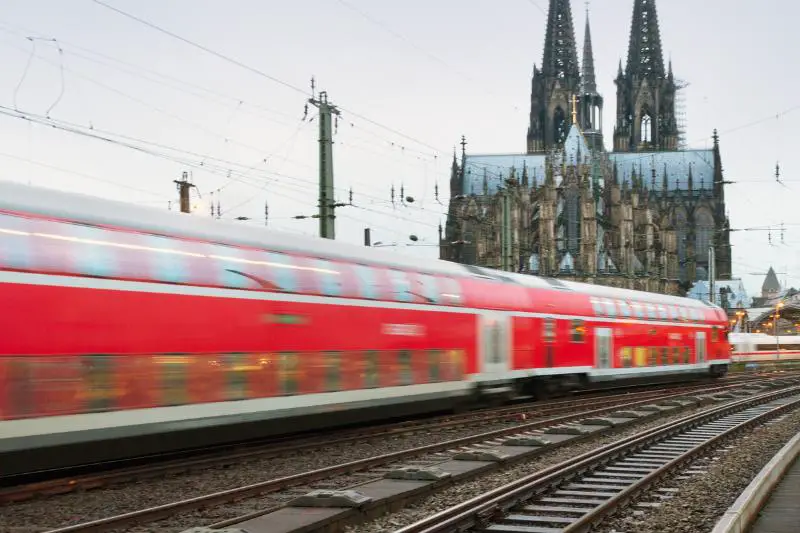
Step aboard a Regionalbahn (RB) or Regionalexpress (RE) and embark on a journey that weaves through the heart of Germany’s towns and countryside. These regional trains are your gateway to the quaint corners and vibrant small towns that are often bypassed by high-speed services.
With the RB focusing on shorter, more frequent stops, and the RE providing quicker connections between larger towns and cities, there’s a pace to suit every traveler’s curiosity.
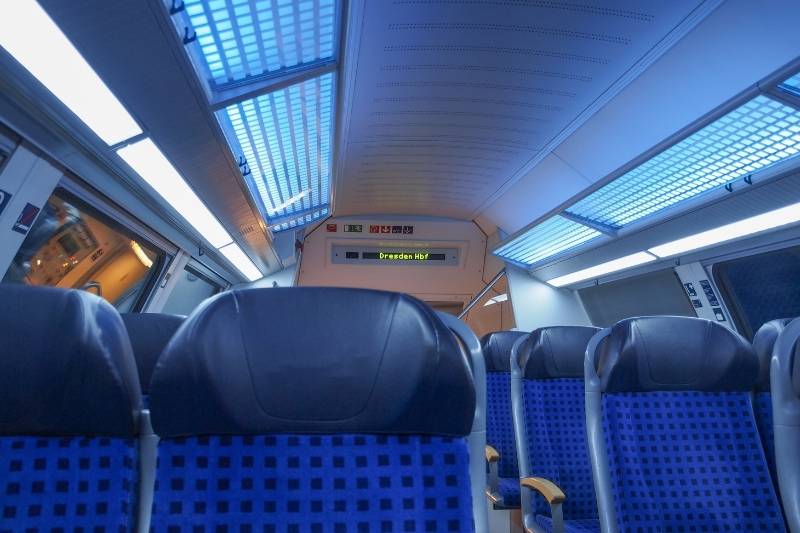
In these trains, you’ll find simple comforts—clean, functional, and punctual service with a local feel. First and second class compartments are usually available, with the former offering a quieter environment and sometimes extra space.
There is usually no seat reservation available, but it’s rare that the trains fill up unless you are traveling in peak hours or around a big event. Try to avoid these times if you can. There also isn’t the luggage space there is on ICE trains.

Prices for tickets for regional trains do not vary, but it does make it less stressful if you buy in advance.
It’s easy to buy your tickets here on the Deutsche Bahn website.
There are also regional trains ran by private companies that won’t start with RB and RE. You can still find these on the Deutsche Bahn site, but they’ll have a different code.
Pros of Traveling on Regional Trains:
- Cost-Effective: Typically, tickets for regional train services are more affordable, especially for short distances.
- Greater Coverage: Explore destinations off the beaten path; these trains stop at smaller stations where high-speed trains do not venture.
- Flexibility: With a regional day pass, you can hop on and off at any stop in the designated area, giving you spontaneous travel freedom.
Cons of Traveling on Regional Trains:
- Slower Speeds: Travel times are longer due to frequent stops, making them less ideal for those on a tight schedule. If you need to travel far, it can be a big time suck.
- Simpler Amenities: While clean and dependable, regional trains offer fewer luxury amenities compared to ICE.
- Peak Hour Crowds: These trains can be crowded during peak commuter times, which might affect seat availability and overall comfort.
- Scheduling: On some less-traveled routes, train frequency can be limited, especially on weekends or public holidays, requiring careful travel planning.
- Luggage: It’s not as convenient with luggage.
Regional trains in Germany are your best pick when you want to go to places or take routes that aren’t covered by the high speed options. They are also a more budget friendly alternative especially with the 49 Euro Deutschland Ticket.
This ticket can take you all over Germany and covers regional trains but not the high-speed trains. You can read more about it here.
Find all train tickets on the Deutsche Bahn website here.
S-Bahn: The Backbone of Urban Commuting
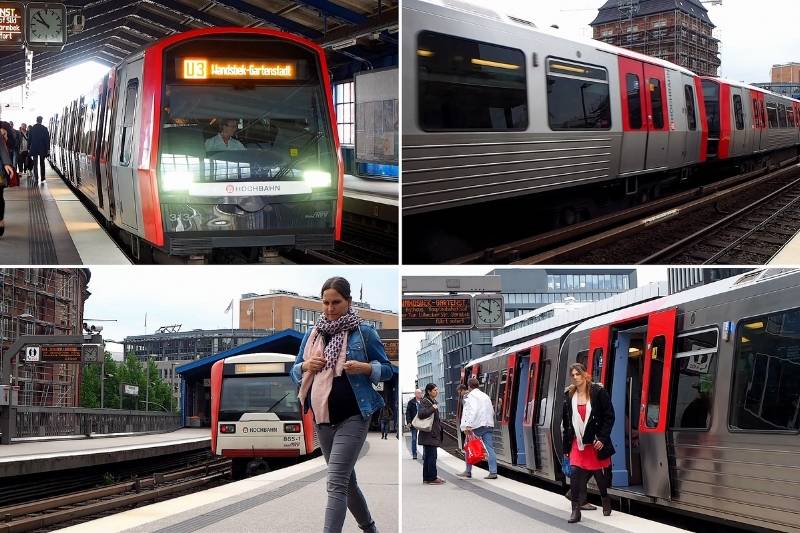
The S-Bahn is a rapid transit railway system that connects urban centers with their outlying suburbs. It is your go-to for swift, reliable service when navigating the buzz of Germany’s major cities.
The term itself stands for “Stadtschnellbahn,” or “city rapid railway,” and it’s easy to see why: the S-Bahn keeps the city’s lifeblood flowing with its frequent departures and expansive reach.
With the S-Bahn, expect an efficient and integrated network that makes getting around straightforward, whether for work or leisure. You’ll often find trains arriving every few minutes during peak hours, ensuring that even if you miss one, another will be along shortly.
And while amenities are basic—prioritizing practicality and speed—the comfort and convenience make it an essential part of urban life.
Pros of Traveling on the S-Bahn:
- Frequency: Regular and high-frequency services reduce wait times and make it easy to plan your travel with minimal disruption.
- Connectivity: The S-Bahn networks are well-connected to other public transport systems, making transfers between buses, trams, U-Bahn, and regional trains seamless.
- Affordability: Tickets are generally less expensive than those for long-distance train services and can be included in transport passes that cover wider city travel.
- Local Flair: Engage in people-watching or catch glimpses of city life as you join residents in their daily commute, giving you an authentic slice of city atmosphere.
Cons of Traveling on the S-Bahn:
- Crowds: Trains can become crowded during peak commute times, which may affect your comfort and the space available to sit or stand.
- Limited Scenery: Being designed for practical city transits, don’t expect panoramic views; most of your journey will be subterranean or within city lines.
- Simple Facilities: The focus is on efficiency rather than luxury, so while you’ll reach your destination effectively, don’t anticipate lavish amenities.
The S-Bahn is the right choice when you’re navigating within a city and its surrounding areas. Sometimes, there is the choice between the S-bahn and a regional train. I prefer the regional train in these cases.
The S-Bahn is also covered in the 49 Euro Deutschland ticket.
U-Bahn: Navigating the City’s Underbelly
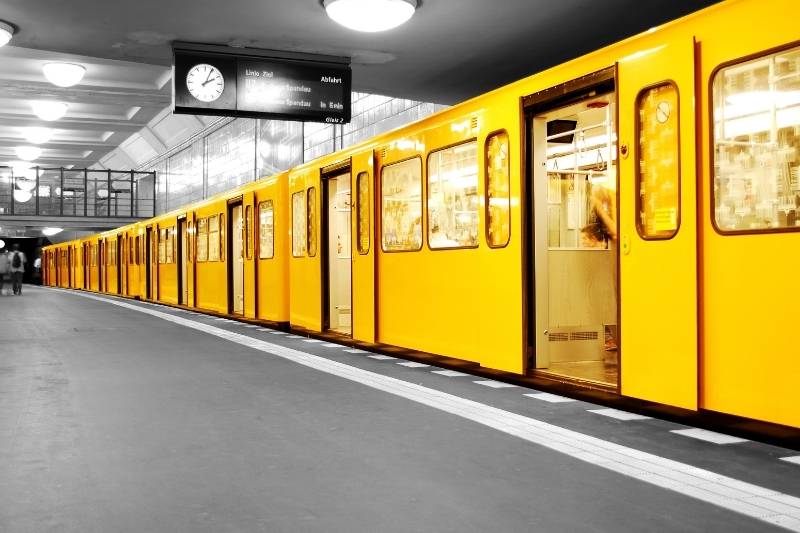
Slide into the depths of Germany’s urban centers on the U-Bahn, the underground subway system that snakes beneath city streets. As you descend from the bustling cityscape into the U-Bahn station, you step into a world that efficiently shuttles locals and visitors alike away from surface traffic and weather whims.
In cities like Berlin, Munich, and Hamburg, the U-Bahn isn’t just a mode of transport — it’s an essential piece of the urban puzzle.
Riding the U-Bahn, you’ll appreciate its clockwork-like regularity, with trains frequently arriving every few minutes during peak times. Each train is a swift whisper through subterranean tunnels, delivering you close to museums, theatres, shops, and restaurants.
Pros of Traveling on the U-Bahn:
- Speed: The U-Bahn bypasses surface traffic, making it one of the fastest ways to travel short distances within a city.
- Convenience: Stations are often closely spaced, meaning you’re seldom far from a departure point or your destination.
- Frequency: With trains arriving regularly and often round the clock, the U-Bahn offers reliability that keeps your day fluid and stress-free.
- Accessibility: These underground trains are designed for easy boarding, appealing to passengers of all mobility levels.
Cons of Traveling on the U-Bahn:
- Rush Hours: Like the S-Bahn, the U-Bahn can become intensely crowded during peak commute times, potentially challenging your sense of personal space.
- Orientation: First-time visitors might find the network of lines and connections daunting, though station signage and maps are designed to aid navigation.
- Limited Views: As an underground service, the U-Bahn offers no scenic vistas; it’s a purely functional ride focusing on getting you from A to B.
The U-Bahn is often your best option when traveling within a city when it exists.
The U-Bahn is also covered in the 49 Euro Deutschland ticket.
Practical Tips for Train Travel in Germany

When you’ve familiarized yourself with the different types of trains and grasped the essentials of ticketing, there are still a few insider tips that can elevate your travel experience. These practical pieces of advice will ensure that your rail journey through Germany is both enjoyable and efficient.
Buy your tickets in advance for the best prices on high-speed trains. On regional trains, it’ll also help you be organized.
Find all train options on the Deutsche Bahn website here.
Pack light and smart, bearing in mind that some trains, especially regional ones, may have limited space for luggage. You’ll want to navigate stations and carriages with ease. On long-distance trains like the ICE, look out for dedicated luggage areas and overhead storage to keep your belongings secure and out of the aisle. Ideally, reserve your seats near these areas.
Timeliness is a cornerstone of German culture, particularly when it comes to rail transport. Aim to arrive at the station a bit earlier than your departure time, so you can locate your platform without rushing and maybe even grab a coffee along the way. This will also give you some buffer should you need to tackle ticket vending machines or have any problems.
Connectivity on trains can vary; while ICE trains boast free Wi-Fi, don’t expect the same on all regional or local services. If staying connected is essential, consider a local SIM card or mobile Wi-Fi to ensure uninterrupted internet access during your travels. If you have a ticket like the Deutschland ticket, you need to be able to show it on your phone to any inspectors so having data for your device is essential.
Lastly, familiarize yourself with the routes and stops before you board. While announcements are made on the trains, they may be in German, and knowing where you are heading can help avoid any confusion. Apps like DB Navigator provided by Deutsche Bahn offer real-time train information, route planners, and even platform details to keep you on the right track.
Embrace these tidbits of knowledge, and you’re set for a successful and enjoyable German train adventure, weaving your way through the country’s rich landscapes and vibrant cities with the poise of an experienced traveler.
In the interweaving railway lines of Germany, you’ll find an embodiment of efficiency and diversity—each train type designed with a unique purpose in mind. From the lightning-fast ICE connecting major cities to the intricate networks of the S-Bahn and U-Bahn bringing life to urban landscapes, the German rail system is a testament to thoughtful engineering and passenger-centric design.
Embarking on a journey through this extensive system not only connects you with the far reaches of the country but also provides a lesson in the German way of life—reliable, and comfortably efficient.
Find all train options on the Deutsche Bahn website here.
Click here to read more about 49 Euro public transport ticket that will take you everywhere and here for apps you need on your phone for Germany. You can also find our guide to all the different ways to get around Germany here. Learn more about planning your trip to Germany here.

